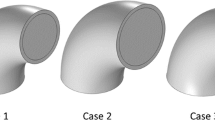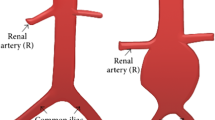Abstract
We present a comprehensive and original framework for the biomechanical analysis of patients affected by ascending thoracic aorta aneurysm and aortic insufficiency. Our aim is to obtain crucial indications about the role played by deranged hemodynamics on the ATAAs risk of rupture. Computational fluid dynamics analysis was performed using patient-specific geometries and boundary conditions derived from 4D MRI. Blood flow helicity and wall shear stress descriptors were assessed. A bulge inflation test was carried out in vitro on the 4 ATAAs after surgical repair. The healthy volunteers showed no eccentric blood flow, a mean TAWSS of 1.5 ± 0.3 Pa and mean OSI of 0.325 ± 0.025. In 3 aneurismal patients, jet flow impingement on the aortic wall resulted in large TAWSS values and low OSI which were amplified by the AI degree. However, the tissue strength did not appear to be significantly reduced. The fourth patient, which showed the lowest TAWSS due to the absence of jet flow, had the smallest strength in vitro. Interestingly this patient presented a bovine arch abnormality. Jet flow impingement with high WSS values is frequent in ATAAs and our methodology seems to be appropriate for determining whether it may increase the risk of rupture or not.





Similar content being viewed by others
References
Al-Atassi, T., M. Hynes, B. Sohmer, B.-K. Lam, T. Mesana, and M. Boodhwani. Aortic root geometry in bicuspid aortic insufficiency versus stenosis: implications for valve repair. Eur. J. Cardiothorac. Surg. 47:e151–e154, 2015.
Barker, A. J., C. Lanning, and R. Shandas. Quantification of hemodynamic wall shear stress in patients with bicuspid aortic valve using phase-contrast MRI. Ann. Biomed. Eng. 38:788–800, 2010.
Barker, A. J., M. Markl, J. Bürk, R. Lorenz, J. Bock, S. Bauer, J. Schulz-Menger, and F. von Knobelsdorff-Brenkenhoff. Bicuspid aortic valve is associated with altered wall shear stress in the ascending aorta. Circ. Cardiovasc. Imaging 5:457–466, 2012.
Bellini, C., A. Korneva, L. Zilberberg, F. Ramirez, D. B. Rifkin, and J. D. Humphrey. Differential ascending and descending aortic mechanics parallel aneurysmal propensity in a mouse model of Marfan syndrome. J. Biomech. 49:2383–2389, 2016.
Bürk, J., P. Blanke, Z. Stankovic, A. J. Barker, M. Russe, J. Geiger, A. Frydrychowicz, M. Langer, and M. Markl. Evaluation of 3D blood flow patterns and wall shear stress in the normal and dilated thoracic aorta using flow-sensitive 4D CMR. J. Cardiovasc. Magn. Reson. 14:84, 2012.
Callaghan, F. M., J. Karkouri, K. Broadhouse, M. Evin, D. F. Fletcher, and S. M. Grieve. Thoracic aortic aneurysm: 4D flow MRI and computational fluid dynamics model. Comput. Methods Biomech. Biomed. Eng. 18:1894–1895, 2015.
Chau, K. H., and J. A. Elefteriades. Natural history of thoracic aortic aneurysms: size matters, plus moving beyond size. Prog. Cardiovasc. Dis. 56:74–80, 2013.
Childs, H., L. Ma, M. Ma, J. Clarke, M. Cocker, J. Green, O. Strohm, and M. G. Friedrich. Comparison of long and short axis quantification of left ventricular volume parameters by cardiovascular magnetic resonance, with ex vivo validation. J. Cardiovasc. Magn. Reson. 13:40, 2011.
Choudhury, N., O. Bouchot, L. Rouleau, D. Tremblay, R. Cartier, J. Butany, R. Mongrain, and R. L. Leask. Local mechanical and structural properties of healthy and diseased human ascending aorta tissue. Cardiovasc. Pathol. 18:83–91, 2009.
David, T. E., C. M. Feindel, and J. Bos. Repair of the aortic valve in patients with aortic insufficiency and aortic root aneurysm. J. Thorac. Cardiovasc. Surg. 109:345–352, 1995.
Dillon-Murphy, D., A. Noorani, D. Nordsletten, and C. A. Figueroa. Multi-modality image-based computational analysis of haemodynamics in aortic dissection. Biomech. Model. Mechanobiol. 15:857–876, 2016.
Duprey, A., O. Trabelsi, M. Vola, J.-P. Favre, and S. Avril. Biaxial rupture properties of ascending thoracic aortic aneurysms. Acta Biomater. 42:273–285, 2016.
Fytanidis, D. K., J. V. Soulis, and G. D. Giannoglou. Patient-specific arterial system flow oscillation. Hippokratia 18:162–165, 2014.
Gallo, D., D. A. Steinman, P. B. Bijari, and U. Morbiducci. Helical flow in carotid bifurcation as surrogate marker of exposure to disturbed shear. J. Biomech. 45(14):2398–2404, 2012.
Garcia, J., A. J. Barker, J. D. Collins, J. C. Carr, and M. Markl. Volumetric quantification of absolute local normalized helicity in patients with bicuspid aortic valve and aortic dilatation. Magn. Res. Med. 78:689–701, 2017.
Gijsen, F. J. H., F. N. van de Vosse, and J. D. Janssen. The influence of the non-Newtonian properties of blood on the flow in large arteries: steady flow in a carotid bifurcation model. J. Biomech. 32:601–608, 1999.
Girdauskas, E., and M. Rouman. Is there any difference in aortic wall quality between patients with bicuspid aortic valve stenosis and those with bicuspid aortic valve insufficiency? Eur. J. Cardiothorac Surg. 2:337, 2014.
Guzzardi, D. G., A. J. Barker, P. van Ooij, S. C. Malaisrie, J. J. Puthumana, D. D. Belke, H. E. M. Mewhort, D. A. Svystonyuk, S. Kang, S. Verma, J. Collins, J. Carr, R. O. Bonow, M. Markl, J. D. Thomas, P. M. McCarthy, and P. W. M. Fedak. Valve-related hemodynamics mediate human bicuspid aortopathy: insights from wall shear stress mapping. J. Am. Coll. Cardiol. 66:892–900, 2015.
Hope, M. D., M. Sigovan, S. J. Wrenn, D. Saloner, and P. Dyverfeldt. Magnetic resonance imaging hemodynamic markers of progressive bicuspid aortic valve related aortic disease. J. Magn. Reson. Imaging 40:140–145, 2014.
Hornick, M., R. Moomiaie, H. Mojibian, B. Ziganshin, Z. Almuwaqqat, E. S. Lee, J. A. Rizzo, M. Tranquilli, and J. A. Elefteriades. ‘Bovine’ aortic arch—a marker for thoracic aortic disease. Cardiology 123:116–124, 2012.
Humphrey, J. D. Cardiovascular Solid Mechanics. New York: Springer, 2002.
Humphrey, J. D., M. A. Schwartz, G. Tellides, and D. M. Milewicz. Role of mechanotransduction in vascular biology: focus on thoracic aortic aneurysms and dissections. Circ. Res. 116:1448–1461, 2015.
Isselbacher, E. M. Thoracic and abdominal aortic aneurysms. Circulation 111:816–828, 2005.
Ku, D. N., D. P. Giddens, C. K. Zarins, and S. Glagov. Pulsatile flow and atherosclerosis in the human carotid bifurcation. Positive correlation between plaque location and low oscillating shear stress. Arteriosclerosis 5:293–302, 1985.
Lantz, J., J. Renner, and M. Karlsson. Wall shear stress in a subject specific human aorta—influence of fluid-structure interaction. Int. J. Appl. Mech. 03:759–778, 2011.
Layton, K. F., D. F. Kallmes, H. J. Cloft, E. P. Lindell, and V. S. Cox. Bovine aortic arch variant in humans: clarification of a common misnomer. Am. J. Neuroradiol. 27:1541–1542, 2006.
Michelena, H. I., S. K. Prakash, A. Della Corte, M. M. Bissell, N. Anavekar, P. Mathieu, Y. Bossé, G. Limongelli, E. Bossone, D. W. Benson, P. Lancellotti, E. M. Isselbacher, M. Enriquez-Sarano, T. M. Sundt, 3rd, P. Pibarot, A. Evangelista, D. M. Milewicz, S. C. Body, and BAVCon Investigators. Bicuspid aortic valve: identifying knowledge gaps and rising to the challenge from the international bicuspid aortic valve consortium (BAVCon). Circulation 129:2691–2704, 2014.
Morbiducci, U., R. Ponzini, D. Gallo, C. Bignardi, and G. Rizzo. Inflow boundary conditions for image-based computational hemodynamics: impact of idealized versus measured velocity profiles in the human aorta. J. Biomech. 46:102–109, 2013.
Morbiducci, U., R. Ponzini, M. Grigioni, and A. Redaelli. Helical flow as fluid dynamic signature for atherogenesis risk in aortocoronary bypass. A numeric study. J. Biomech. 40:519–534, 2007.
Morbiducci, U., R. Ponzini, G. Rizzo, M. Cadioli, A. Esposito, F. De Cobelli, A. Del Maschio, F. M. Montevecchi, and A. Redaelli. In vivo quantification of helical blood flow in human aorta by time-resolved three-dimensional cine phase contrast magnetic resonance imaging. Ann. Biomed. Eng. 37(3):516–531, 2009.
Morbiducci, U., R. Ponzini, G. Rizzo, M. Cadioli, A. Esposito, F. M. Montevecchi, and A. Redaelli. Mechanistic insight into the physiological relevance of helical blood flow in the human aorta: an in vivo study. Biomech. Model. Mechanobiol. 10:339–355, 2011.
O’Rourke, M. F., and J. Hashimoto. Mechanical factors in arterial aging: a clinical perspective. J. Am. Coll. Cardiol. 50:1–13, 2007.
Pasta, S., A. Rinaudo, A. Luca, M. Pilato, C. Scardulla, T. G. Gleason, and D. A. Vorp. Difference in hemodynamic and wall stress of ascending thoracic aortic aneurysms with bicuspid and tricuspid aortic valve. J. Biomech. 46:1729–1738, 2013.
Redheuil, A., W. C. Yu, E. Mousseaux, A. A. Harouni, N. Kachenoura, C. O. Wu, D. Bluemke, and J. A. C. Lima. Age-related changes in aortic arch geometry: relationship with proximal aortic function and left ventricular mass and remodeling. J. Am. Coll. Cardiol. 58:1262–1270, 2011.
Sigovan, M., M. D. Hope, P. Dyverfeldt, and D. Saloner. Comparison of four-dimensional flow parameters for quantification of flow eccentricity in the ascending aorta. J. Magn. Reson. Imaging 34(5):1226–1230, 2011.
Soudah, E., E. Y. K. Ng, T. H. Loong, M. Bordone, U. Pua, and S. Narayanan. CFD modelling of abdominal aortic aneurysm on hemodynamic loads using a realistic geometry with CT. Comput. Math. Methods Med. 2013, 2013.
Strecker, C., A. Harloff, W. Wallis, and M. Markl. Flow-sensitive 4D MRI of the thoracic aorta: comparison of image quality, quantitative flow, and wall parameters at 1.5 T and 3 T. J. Magn. Reson. Imaging 36:1097–1103, 2012.
Trabelsi, O., F. M. Davis, J. F. Rodriguez-Matas, A. Duprey, and S. Avril. Patient specific stress and rupture analysis of ascending thoracic aneurysms. J. Biomech. 48:1836–1843, 2015.
Tse, K. M., P. Chiu, H. P. Lee, and P. Ho. Investigation of hemodynamics in the development of dissecting aneurysm within patient-specific dissecting aneurismal aortas using computational fluid dynamics (CFD) simulations. J. Biomech. 44:827–836, 2011.
Xiao, N., J. D. Humphrey, and C. A. Figueroa. Multi-scale computational model of three- dimensional hemodynamics within a deformable full-body arterial network. J. Comput. Phys. 244:2–40, 2013.
Youssefi, P., A. Gomez, H. Taigang, L. Anderson, N. Bunce, R. Sharma, C. A. Figueroa, and M. Jahangiri. Patient-specific computational fluid dynamics and assessment of aortic hemodynamics in a spectrum of aortic valve pathologies. J. Thorac. Cardiovasc. Surg. 153(1):8–20.e3, 2017.
Acknowledgments
This research was supported by the European Research Council (ERC Grant biolochanics, Grant Number 647067). We thank Dr Morbiducci and Dr Gallo from Polytechnic of Turin (Italy) who provided insight and expertise that greatly assisted this research. We are also grateful to Ansys, Inc. for providing Ansys-Fluent (ANSYS® Academic Research, Release 17.0).
Author information
Authors and Affiliations
Corresponding author
Additional information
Associate Editor Estefanía Peña oversaw the review of this article.
Appendix
Rights and permissions
About this article
Cite this article
Condemi, F., Campisi, S., Viallon, M. et al. Fluid- and Biomechanical Analysis of Ascending Thoracic Aorta Aneurysm with Concomitant Aortic Insufficiency. Ann Biomed Eng 45, 2921–2932 (2017). https://doi.org/10.1007/s10439-017-1913-6
Received:
Accepted:
Published:
Issue Date:
DOI: https://doi.org/10.1007/s10439-017-1913-6





